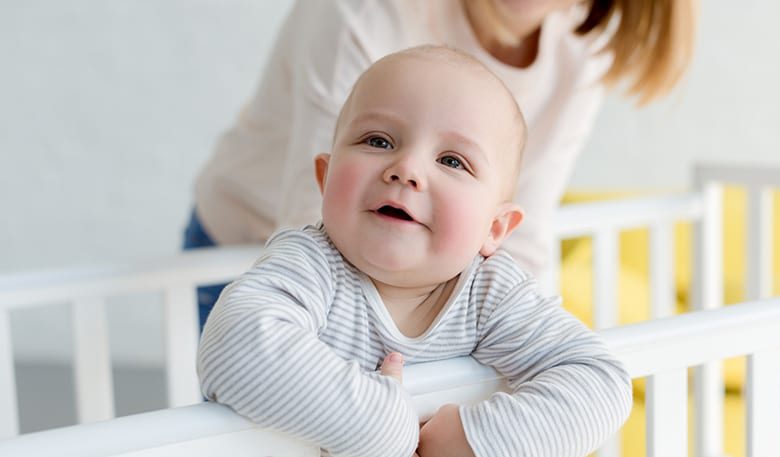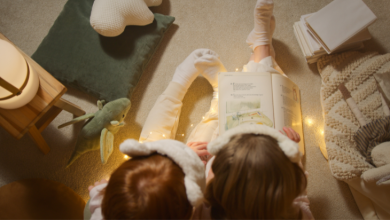Sleep Safe: Infant Sleep Safety

Sleep Safe: Infant Sleep Safety
If you’ve been a parent for longer than five minutes, you’ve probably found this to be true …
Of all the overwhelming things that new parents learn, sleep safety may rank among the most stressful. With so many dos, don’ts, rules, and regulations, it can feel like a tidal wave of anxiety and pamphlets.
We’re here to make things a bit more simple. Here’s a few tips on safe sleeping, safe spaces, and ways you can keep your baby safe without losing any more sleep yourself.
Safe Sleep Spaces
It’s probably not an exaggeration to say that a significant number of parents have a baby’s nursery decorated within days of finding out whether they are having a girl or a boy. And while it may be worthy of a visit from HGTV, some of the decorations and accessories could create an unsafe sleeping space for your little one.
The biggest concern when it comes to infant sleep safety is that something could block the child’s mouth or nose. Until they are in better control of their heads and can roll over on their own, babies don’t have the ability to move things that are blocking their face or change their position so they can breathe better.
Here are some things to think about as you set up your baby’s room. (These guidelines are for children newborn to 6 months old unless we say otherwise.)
- Share a room. The National Institutes for Health (NIH) and the U.S. Department of Health and Human Services recommends you share your room with your baby until they are at least 6 months old. They say it’s ideal to share a room until your child is 1 year old, if you can. Your kiddo should have their own sleep space designed specifically for them, but it should be close to your bed.
- Keep blankets, toys, and other soft objects out of your baby’s crib or bassinet. We know that new teddy bear or blanky is adorable, but loose items in a baby’s sleep space could end up in their face.
- Use a firm mattress with tight-fitting sheets. For the same reason as not including toys and blankets, a firm mattress with tight sheets helps ensure that no loose fabric or bedding gets in the way of your baby breathing freely.
- Ditch the bumper pads. According to The American Academy of Pediatrics, there is no evidence that bumper pads prevent injuries and potentially increase the risk of harm to a baby.
- Keep your cool. Overheating a baby with overly-thick sleeping clothes or by increasing the temperature of the room can do them harm. Err on the side of making the room a little cooler so they don’t overheat. Believe us, if your baby is cold, they’ll let you know …
- Think ahead to a time when your floppy infant becomes a curious baby. As you’re hanging pictures, placing the crib, and setting up furniture, ask yourself, “Would a baby who can stand, reach, and grab things be safe if I placed this here?”
- Remove mobiles once your baby can reach them.
- Don’t put wall hangings above the crib that could fall on the baby or be within arm’s length once they can stand.
- Similarly, don’t place the crib under a window or too close to other furniture. Eventually, everything within your child’s reach is fair game to be explored … and probably broken.
- Watch the mattress height. While infants will be fine to have their mattress at the highest level, standing or crawling babies will need their mattress lowered so they don’t crawl out.
The actual location where your baby is sleeping is also important to keep in mind.
For cribs …
- Crib slats shouldn’t be more than 2-3/8 inches apart. Any new crib you might buy already meets this standard, so no worries there. Older cribs may not.
- If you’re reusing a crib or taking an old one off the hands of a friend or family member, check out the U.S. Consumer Product Safety Commission’s website. Your crib may be involved in a recall or could have been labeled as unsafe since the last time it was used.
For playpens …
- Playpens can be really helpful for parents who may be traveling or can’t have their eyes on their baby 100% of the time. The American Academy of Pediatrics has a great resource on playpen safety that can help you create a safe resting and sleeping space for your baby.
Safe Sleeping Positions
The National Institute for Child Health & Human Development’s (NICHD) “Safe to Sleep®” campaign says to always place a child on their back to sleep. Why? Because back sleeping carries the lowest risk for SIDS (see below). Since attention was brought to back sleeping by the the American Academy of Pediatrics in 1992 and NICHD in 1994, the U.S. SIDS rate has declined by more than 50 percent.
If you’re worried that back sleeping increases your baby’s chance of choking, we have good news. According to the NIH, babies reflexively cough up or swallow if they spit up or vomit.
Making Sense of SIDS/SUID
We understand that SIDS (Sudden Infant Death Syndrome) or the potentially less familiar SUID (Sudden Unexplained Infant Death) is a scary topic. Fortunately, by encouraging parents to lay their babies on their backs and making sure sleep environments are safe, the U.S. has seen drastic decreases in SIDS/SUID totals. The risky time for babies as it relates to SIDS/SUID is from birth to around 6 months of age. After that, the risk dips drastically.
Every resource we’ve listed in this article has information on how to decrease the likelihood of SIDS/SUID. We encourage you to know and follow the basics but not to be frightened or overwhelmed by the specifics. Your pediatrician can answer any questions you have and address any concerns you want to address.
Sleep is precious for both you and your baby. If you’re in the newborn/infant stage with your child now, believe in the promise that they will eventually learn how to sleep (as strange as that sounds) and that you all can sleep safe and sound if you follow a few guidelines. If you’re getting ready to have your baby, be excited! We know you’re being bombarded with a lot right now, but you will do an amazing job.





